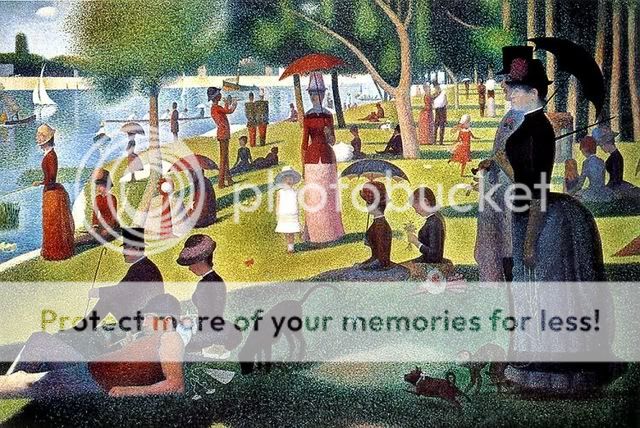Art Sunday 12/07/08: The Technique of Pointillism in Art
Port-en-Bessin, Entrance to the Harbor, 1888 (click to enlarge) George -Pierre Seurat oil on canvas The Museum of Modern Art New York City
George Seurat spent the summer of 1886 in the resort town of Honfleur, on the northern French coast, a region of turbulent seas and rugged shorelines to which artists had long been attracted. But Seurat’s evening scene is hushed and still. Vast sky and tranquil sea bring a sense of spacious light to the picture, yet also have a peculiar visual density. Long lines of cloud echo the breakwaters on the beach—signs of human life and order.
Seurat had used his readings of optical theory to develop a systematic technique, known as pointillism, that involved the creation of form out of small dots of pure color. In the viewer’s eye, these dots can both coalesce into shapes and remain separate particles, generating a magical shimmer. A contemporary critic described the light in Evening, Honfleur and related works as a “gray dust,” as if the transparency of the sky were filled with, or even constituted by, barely visible matter—a sensitive response to the paint’s movement between illusion and material substance, as the dots both merge to describe the scene and break into grains of pigment.
Seurat paints a frame around the scene—buffering a transition between the world of the painting and reality; and, at the upper right, the dots on the frame grow lighter, lengthening the rays of the setting sun.
Here are three more examples of pointillism used in Seurat’s work:

Evening, Honfleur 1886 Oil on canvas The Museum of Modern Art New York City

The Channel at Gravelines Evening Summer, 1890 Oil on canvas The Museum of Modern Art New York City

Sunday Afternoon on the Island of La Grande Jatte 1884 Oil on canvas Art Institue of Chicago
All info was obtained from the website of the Museum of Modern Art.
|
caramonmajere wrote on Dec 7, ’08
Very interesting, I’ll read up it some more.
|
|
gapeach7355 wrote on Dec 7, ’08
Pointillism is such an interesting technique…you can get lost in it up close…and be pulled into its effect from a distance. I love the Seurat of the Eiffel Tower.
|
|
asolotraveler wrote on Dec 7, ’08
luscious post – thanks for notifying me!
|
|
lauritasita wrote on Dec 7, ’08
It reminds me of pixels in digital photography.
|
|
starfishred wrote on Dec 7, ’08
interesting art form not my fav but interesting they look even more interesting when you see them for real makes you wonder why they started this and what was the logic behid it-
|
|
lauritasita wrote on Dec 8, ’08
It is best to view these paintings from a distance to really see them.
|
|
lauritasita wrote on Dec 9, ’08
Heidi, in art, there doesn’t have to be any logic behind artistic expression. It’s merely for the enjoyment of viewers. It’s just like any other artistic technique, just another way to express art.
|
|
sanssouciblogs wrote on Dec 10, ’08
Always loved Seurat and the pointilism school; very amazing, and yes, does look like pixles!
|
|
forgetmenot525 wrote on Dec 11, ’08
Hi sorry it took me so long to get here………….better late than never 🙂 I have always liked this guy, he’s referred to as one of the French impressionists but he is really different to the others, his technique is brilliant, and like others have said, so like modern day TV pictures and digital images…….wow……..hows that for being well before his time Thanks Laurita, another wonderful Art Blog.
|
|
lauritasita wrote on Dec 11, ’08
He’s a very interesting painter, I agree.
|


Comments
Art Sunday 12/07/08: The Technique of Pointillism in Art — No Comments
HTML tags allowed in your comment: <a href="" title=""> <abbr title=""> <acronym title=""> <b> <blockquote cite=""> <cite> <code> <del datetime=""> <em> <i> <q cite=""> <s> <strike> <strong>